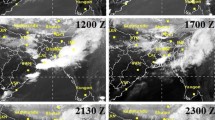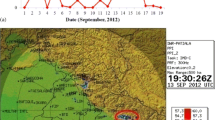Abstract
Space–time evolution of a severe hailstorm occurred over the western India as revealed by WRF-ARW simulations are presented. We simulated a specific event centered over Baramati (18.15°N, 74.58°E, 537 m AMSL) on March 9, 2014. A physical mechanism, proposed as a conceptual model, signifies the role of multiple convective cells organizing through outflows leading to a cold frontal type flow, in the presence of a low over the northern Arabian Sea, propagates from NW to SE triggering deep convection and precipitation. A ‘U’ shaped cold pool encircled by a converging boundary forms to the north of Baramati due to precipitation behind the moisture convergence line with strong updrafts (~15 ms−1) leading to convective clouds extending up to ~ 8 km in a narrow region of ~ 30 km. The outflows from the convective clouds merge with the opposing southerly or southwesterly winds from the Arabian Sea and southerly or southeasterly winds from the Bay of Bengal resulting in moisture convergence (maximum 80 × 10−3 g kg−1 s−1). The vertical profile of the area-averaged moisture convergence over the cold pool shows strong convergence above 850 hPa and divergence near the surface indicating elevated convection. Radar reflectivity (50–60 dBZ) and vertical component of vorticity maximum (~0.01–0.14 s−1) are observed along the convergence zone. Stratiform clouds ahead of the squall line and parallel wind flow at 850 hPa and nearly perpendicular flow at higher levels relative to squall line as evidenced by relatively low and wide-spread reflectivity suggests that organizational mode of squall line may be categorized as ‘Mixed Mode’ type where northern part can be a parallel stratiform while the southern part resembles with a leading stratiform. Simulated rainfall (grid scale 27 km) leads the observed rainfall by 1 h while its magnitude is ~2 times of the observed rainfall (grid scale ~100 km) derived from Kalpana-1. Thus, this study indicates that under synoptically favorable conditions, WRF-ARW could simulate thunderstorm evolution reasonably well although there is some space–time error which might, perhaps, be the reason for lower CAPE (observed by upper air sounding) on the simulation day.











Similar content being viewed by others
References
Agnihotri G, Dimri AP (2015a) Vertical structure of atmosphere in pre-monsoon season over Bangalore. J Earth Syst Sci 124:1563–1572. doi:10.1007/s12040-015-0612-7
Agnihotri G, Dimri AP (2015b) Vertical structure of atmosphere in pre-monsoon season over Banglore. J Earth Syst Sci 124(7):1563–1572
Anderson ME, Carey LD, Petersen WA, Knupp KR (2011) C-band dual-polarimetric radar signatures of hail. Electron J Operational Meteor 12(2):1–30
Banacos PC, Schultz DM (2005) The use of moisture flux convergence in forecasting convective initiation: historical and operational perspectives. Weather Forecast 20:351–366. doi:10.1175/WAF858.1
Bothwell PD (1988) Forecasting convection with the AFOS Data Analysis Programs (ADAP-VERSION 2.0). NOAA Technical Memorandum NWS SR-122, NOAA/NWS Southern Region, Fort Worth
Ceperuelo M, Llasat MC, Rigo T (2006) Rainfall events and Hailstorms Analysis Program (RHAP). Adv Geosci 7(205–213):2006
Chatterjee RN, Prakash P, Singh G (1995) Frequency of thunderstorm occurrence and their height distribution in different regions in India—a radar study. Vayu Mandal J Ind Meteorol Soc 25:41–46
Chaudhuri S (2008) Preferred type of cloud in the genesis of severe thunderstorms—a soft computing approach. Atmos Res 88:149–156
Chevuturi A, Dimri AP (2015) Inter-comparison of physical processes associated with winter and non-winter hailstorms using the Weather Research and Forecasting (WRF) model. Model Earth Syst Environ. doi:10.1007/s40808-015-0014-5
Colman BR (1990a) Thunderstorms above frontal surfaces in environments without positive CAPE. Part I: a climatology. Mon Weather Rev 118:1103–1121
Colman BR (1990b) Thunderstorms above frontal surfaces in environments without positive CAPE. Part II: organization and instability mechanisms. Mon Weather Rev 118:1123–1144
Dalal S, Lohar D, Sarkar S, Sadhukhan I, Debnath GC (2012) Organizational modes of squall-type mesoscale convective systems during premonsoon season over eastern India. Atmos Res 106:120–138
Dimri AP, Niyogi D, Barros AP, Ridley J, Mohanty UC, Yasunari T, Sikka DR (2015) Western disturbance: a review. Rev Geophys. doi:10.1002/2014RG000460
Doswell CA III (1982) The operational meteorology of convective weather, volume 1; Operational mesoanalysis, NOAA Technical Memorandum NWS heavy rainfall over the central United States. Weather Forecast 18:861–878
Dudhia J (1989) Numerical study of convection observed during the winter monsoon experiment using a mesoscale two-dimensional model. J Atmos Sci 46:3077–3107
Gilleland E, Ahijevych DA, Brown BG, Ebert EE (2010) Verifying forecasts spatially. Bull Am Soc 91:1365–1373
Hirt WD (1982) Short-term prediction of convective development using dew-point convergence. In: Ninth conference on weather forecasting and analysis, Seattle. Amer. Meteor. Soc, pp 201–205 (preprints)
Houze RA Jr (1993) Cloud dynamics. Academic Press, New York
Houze RA Jr (2012) Orographic effects on precipitating clouds. Rev Geophys 50:RG1001. doi:10.1029/2011RG000365
Hudson HR (1971) On the relationship between horizontal moisture convergence and convective cloud formation. J Appl Meteorol 10:755–762
Koteswaram P, Srinivasan V (1958) Thunderstorms over Gangetic West Bengal in the pre-monsoon season and the synoptic factors favorable for their formation. Ind J Meteorol Geophys 9:301–312
Kulkarni JR, Morwal SB, Narkhedkar SG, Maheskumar RS, Padmakumari B, Sunitha Devi S, Rajeevan M (2015) Unprecedented hailstorms over north peninsular India during February–March 2014. J Geophys Res Atmos. doi:10.1002/2015JD023093
Litta AJ, Mohanty UC (2008) Simulation of a severe thunderstorm event during the field experiment of STORM programme 2006, using WRFNMM model. Curr Sci 95(2):204–215
Madala S, Satyanarayana ANV, Narayana Rao T (2014) Performance evaluation of PBL and cumulus parameterization schemes of WRF ARW model in simulating severe thunderstorm events over Gadanki MST radar facility—case study. Atmos Res 139:1–17. doi:10.1016/j.atmosres.2013.12.017
Mlawer EJ, Taubman SJ, Brown PD, Iacano MJ, Clough SA (1997) Radiative transfer for inhomogeneous atmosphere: RRTM, a validate correlated-k model for the longwave. J Geophys Res 102:16663–16682
Moore JT, Glass FH, Graves CE, Rochette SM, Singer MJ (2003) The environment of warm season elevated thunderstorms associated with heavy rainfall over the central United States. Weather Forecast 18:861–878
Morrison H, Thompson G, Tatarskii V (2009) Impact of cloud microphysics on the development of trailing stratiform precipitation in a simulated squall line: comparison of one and two-moment schemes. Mon Weather Rev 137:991–1006
Murthy BS, Latha R, Sreeja P (2013) Boundary layer jet on the lee side of Western Ghats during southwest monsoon as revealed by high resolution solar winds. J Atmos Solar Terrest Phys. doi:10.1016/j.jastp.2013.09.002
Newman WR (1971) The relationship between horizontal moisture convergence and severe storm occurrences. M.S. thesis, School of Meteorology, University of Oklahoma. Available from School of Meteorology, University of Oklahoma, 100 E. Boyd, Rm. 1310, Norman, OK 73019
Parker MD, Johnson RH (2000) Organizational modes of midlatitude mesoscale convective systems. Mon Weather Rev 128:3413–3436
Parker MD, Johnson RH (2004) Simulated convective lines with leading precipitation. Part II: evolution and maintenance. J Atmos Sci 61:1656–1673
Poljack G, Prtenjak MT, Kvakić M, Strelec Mahović N, Babić K (2014) Wind patterns associated with the development of daytime thunderstorms over Istria. Ann Geophys 32(401–420):2014. doi:10.5194/angeo-32-401-2014
Rajeevan M, Kesarkar A, Thampi SB, Rao TN, Radhakrishna B, Rajasekhar M (2010) Sensitivity of WRF cloud microphysics to simulations of a severe thunderstorm event over Southeast India. Ann Geophys 28:603–619
Sadhukhan I, Lohar D, Pal DK (2000) Premonsoon season rainfall variability over Gangetic West Bengal and its neighbourhood, India. Int J Climatol 20:1485–1493
Singh H, Singh OP (2013) Satellite derived precipitation estimates over Indian region during southwest monsoons. J Ind Geophys Union 17:65–74
Smolarkiewicz PK, Rotunno R (1989) Low Froude number flow past three dimensional obstacles: part I. Baroclinically generated lee vortices. J Atmos Sci 46:1154–1164. doi:10.1175/1520-0469
Srinivasan V, Ramamurthy K, Nene YR (1973) Summer-Nor’westers and Andhis and large scale convective activity over peninsular and central parts of the country. IMD Forecasting Manual, FMU Rep. No. III-2.2, Discussion of typical synoptic weather situations
Tyagi B, Satyanarayana ANV, Vissa NK (2013) Thermodynamical structure of atmosphere during pre-monsoon thunderstorm season over Kharagpur as revealed by STORM data. Pure Appl Geophys 170:675–687
Waldstreicher JS (1989) A guide to utilizing moisture flux convergence as a predictor of convection. Nat Weather Dig 14(4):20–35
Wang D, Miao J, Tan Z (2013) Impacts of topography and land cover change on thunderstorm over the Huangshan (Yellow Mountain) area of China. Nat Hazards 67:675–699. doi:10.1007/s11069-013-0595-0
Wang D, Miao J, Zhang D (2015) Numerical simulations of local circulation and its response to land cover changes over the Yellow Mountains of China. J Meteorol Res 29:667–681. doi:10.1007/s13351-015-4070-6
Weston KJ (1972) The dryline of northern India and its role in cumulonimbus convection. Q J R Meteorol Soc 98:519–531
Acknowledgements
The authors would like to thank India Meteorological Department for providing daily weather reports and Kalpana-1 rainfall. NCEP/NCAR is thankfully acknowledged for reanalysis charts. QPE and OLR images were obtained from ISRO’s MOSDAC site.
Author information
Authors and Affiliations
Corresponding author
Additional information
Responsible Editor: J.-F. Miao.
Electronic supplementary material
Below is the link to the electronic supplementary material.
Time evolution of various parameters at every 30 min interval is explained with figures (referred as SFigure or SFig) provided in ‘supplementary material’. Important figures illustrating convection initiation and its peak stage just before precipitation only are given in the main paper.
Rights and permissions
About this article
Cite this article
Murthy, B.S., Latha, R. & Madhuparna, H. WRF simulation of a severe hailstorm over Baramati: a study into the space–time evolution. Meteorol Atmos Phys 130, 153–167 (2018). https://doi.org/10.1007/s00703-017-0516-y
Received:
Accepted:
Published:
Issue Date:
DOI: https://doi.org/10.1007/s00703-017-0516-y




